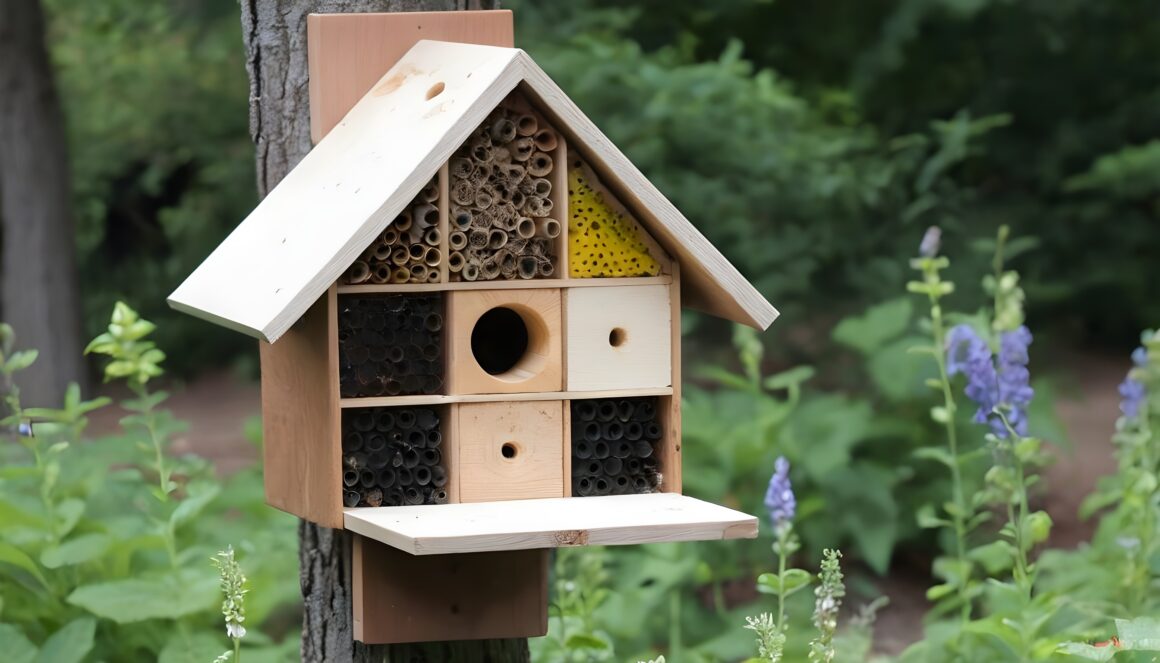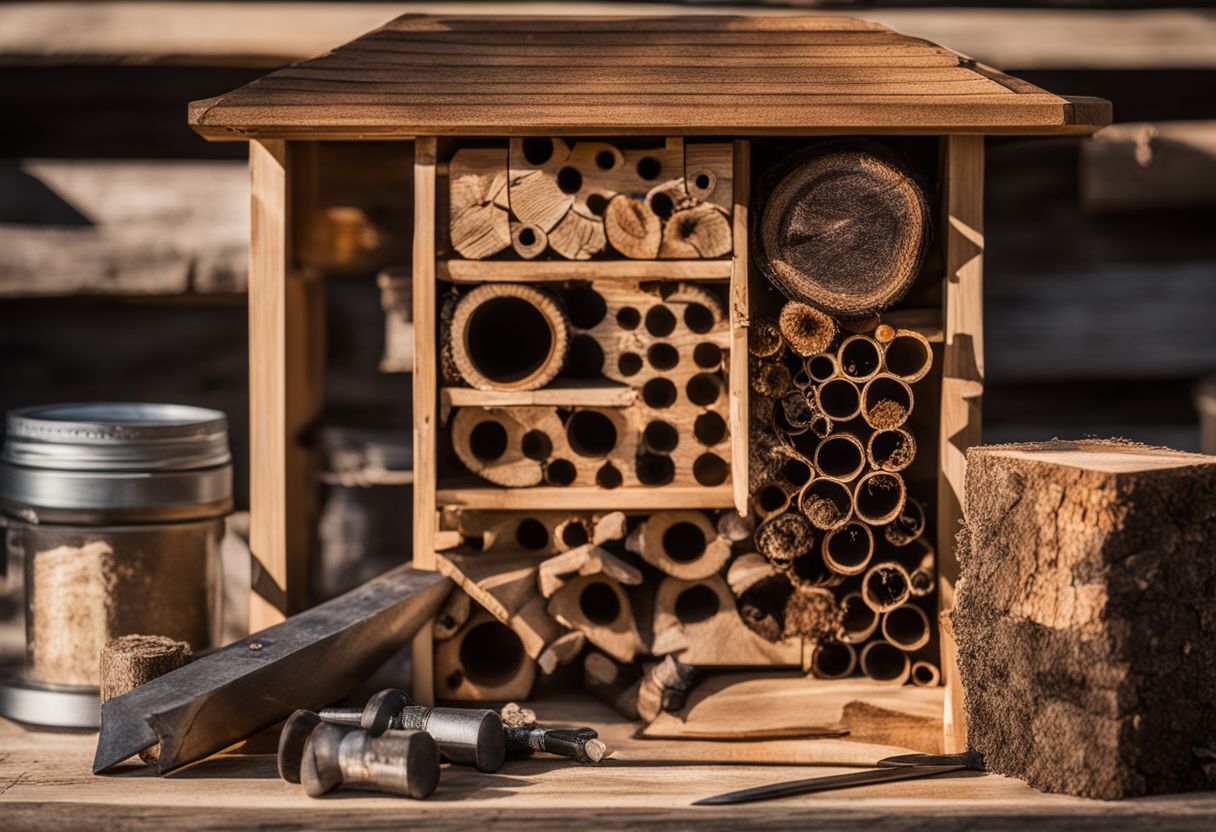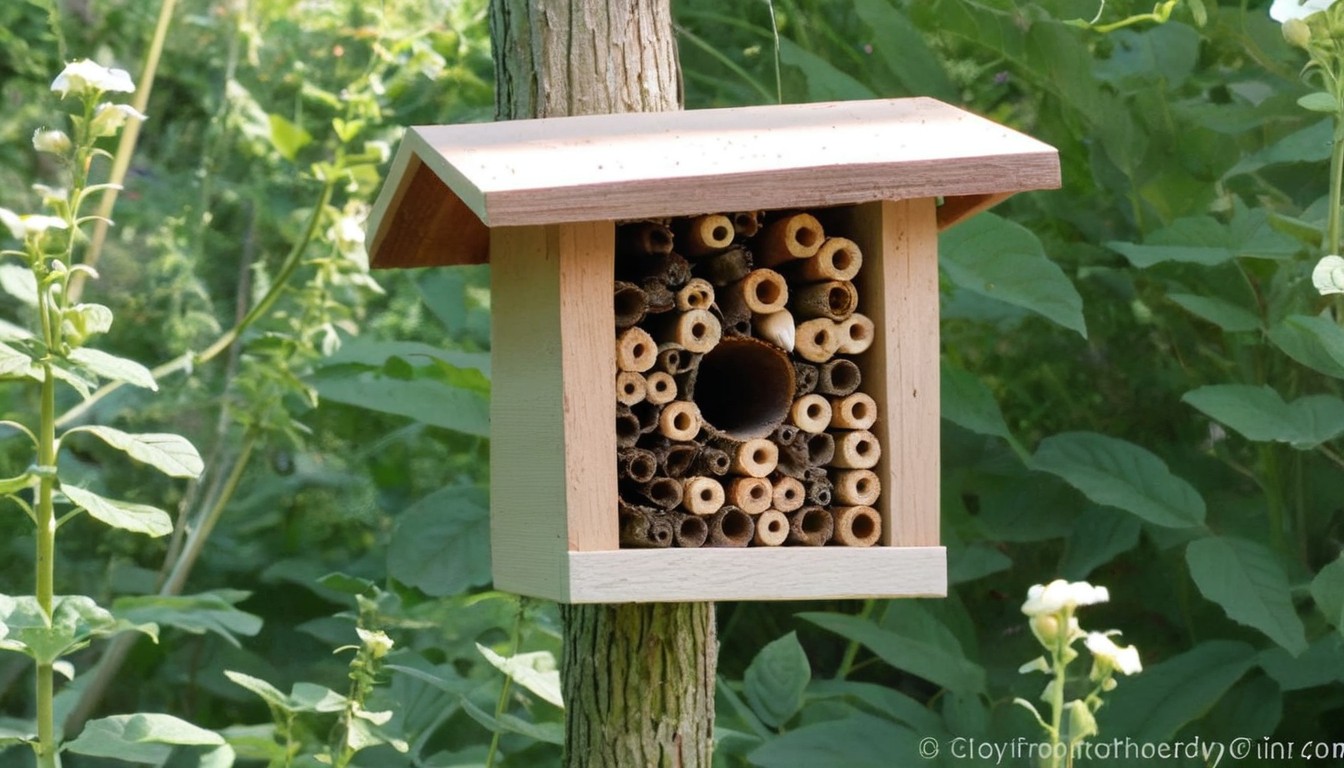Are you noticing small round holes in your wooden structures? Carpenter bees can cause damage by drilling into wood to make their homes. This article will guide you through building a carpenter bee house, offering these buzzing friends an alternative place to reside.
You’ll learn how to create a welcoming spot for them that keeps your home and garden safe. Get ready for some DIY!
Why Build a Carpenter Bee House for Your Home and Garden
Building a carpenter bee house helps keep your home and garden safe. It gives bees their own space, so they leave your wood alone.
Benefits of attracting carpenter bees
Carpenter bees play a significant role as pollinators in your garden and crops. They help plants grow, breed, and produce food. You draw them away from your house structures by making a home for carpenter bees.
It means they are less likely to nest in decks or furniture. A bee house provides a safe spot for these bees to live and work. This is good because it keeps wooden parts of your home safe while helping the environment.
Having carpenter bees around can significantly improve the health of your plants. They are especially good at pollinating flowers that other bees might not visit. So, attracting them benefits everyone—your garden gets the best care, and wooden structures stay damage-free.
Plus, supporting the bee population by offering them nesting sites helps maintain balance in our ecosystem.
Protecting your home and garden from wood damage
Fixing holes in decks and home exteriors stops bees from taking them home. Cover or fill carpenter bee holes with steel wool, wood putty, and paint to keep them out. This keeps your wood safe and sound.
Materials and Tools Needed
To start building a carpenter bee house, you’ll need some specific types of wood and tools. Choosing suitable materials makes all the difference in creating a sturdy and welcoming bee home.
Types of wood to use
Cedar, pine, and bamboo are the top choices for building a carpenter bee house. Cedarwood stands out because it naturally fights off insects and decay, making it last longer. Pine offers a less expensive route without skimping on quality, it’s still solid and practical.
Bamboo is another fantastic option, prized for its challenging nature and being eco-friendly. Each type of wood has its benefits, so picking one depends on what you value most: durability, cost-effectiveness, or environmental impact.
Using cedar guarantees a sturdy home that resists pests without extra chemicals. If budget is your main concern, go with pine – it does the job well at a lower price. Bamboo is the way to go for those who prioritize green living; it’s renewable and excellent.
Whether you choose – cedar, pine, or bamboo – your bee house will be a pollinator haven.
Necessary tools for construction
To build a carpenter bee house, you need some essential tools. Grab untreated wood, a drill to make holes for the bees, and a saw to cut the wood. Sandpaper helps smooth out rough edges, protecting these beneficial pollinators.
Steps to Building a Carpenter Bee House
First, you cut the wood to size, ensuring each piece fits just right. Then, putting it all together requires careful hands and the right tools, simple as that.
Measuring and cutting wood
Measuring and cutting wood requires attention to detail. It’s crucial to have specific dimensions for your carpenter bee house. Grab a tape measure, mark the lengths, and cut along these lines.
A saw will do the job nicely, ensuring each piece fits together well.
Once you have all the pieces cut to size, it’s time to move on to putting them together correctly.
Proper assembly techniques
To build a carpenter bee house, drill holes in untreated wood to create nesting tunnels. These should be about 5/8 inch in diameter for the best fit. Keep the holes clean and smooth with sandpaper to protect the bees.
Next, cut your wood pieces to size using a saw. The back piece should be solid to support the structure securely.
Assemble all parts tightly with screws, ensuring no gaps or loose ends. It ensures your bee house remains sturdy and safe for bees over time. Now, let’s talk about where and how to set up your new bee house in your garden or yard.
Placement and Maintenance of the Bee House
Finding the right spot for your bee house is key: somewhere sunny but not too hot. Keep it clean and check on it often to ensure your bee guests are happy.
Choosing the right location
Choosing the right spot for your carpenter bee house is vital. It should draw them away from other wooden parts of your home and garden. Find a place where these bees like to fly around, or try making nests.
It shows they’re interested in that area.
Make sure the spot gets plenty of sunshine and has some shelter. Bees love sunny places but also need protection from harsh weather. Putting the bee house near flowers can also help, giving bees easy access to food.
This simple step makes your bee house more inviting and helps protect your property.
Regular cleaning and maintenance
Keeping your carpenter’s bee house clean and in good shape is vital. Check it often for mud or blockages in the tubes. Remove any old nests or debris. It helps keep the bees healthy and happy.
Ensure the roof and walls are secure to protect from rain or pests.
Next, find out how planting certain flowers can bring more bees to your garden.
Other Ways to Attract Carpenter Bees
Want more carpenter bees around? Try adding colorful flowers and a water spot near the bee house. These simple steps can make your garden a favorite place for these helpful bees.
Planting bee-friendly flowers and plants helps attract bees to your garden instead of your home. Flowers like lavender, sunflowers, and clover are good for bees. They find these plants attractive and decide to visit them more often.
This action keeps the bees busy in your garden, away from places you don’t want them, and it also makes your garden look beautiful.Next up is providing a water source for the bees. Just like us, bees get thirsty too.
Providing a water source
After planting bee-friendly flowers, adding a water source is crucial. Set up shallow water dishes with pebbles for carpenter bees to land on and drink from. This simple step keeps them hydrated and away from your home.
A nearby water container can significantly reduce the chance of bees nesting in wood structures around your garden or house.
Regularly checking these water sources ensures they remain clean and filled. It attracts carpenter bees and promotes a healthy environment for other pollinators.
Such care is crucial in maintaining the balance between having bees as beneficial guests rather than unwanted wood-boring pests around your living spaces.
FAQs
1. What is a carpenter bee house?
A carpenter bee house is a handcrafted home for bees, designed to lure them away from your garden and home. It’s made to provide a safe spot for solitary bees, like mason bees, to nest and pollinate without damaging wood structures around your space.
2. Why should I build one?
Building a carpenter bee house helps protect your wooden structures from being drilled into by these buzzing critters. Plus, it supports the local bee population, vital for pollinating plants in your garden!
3. How do I make a carpenter bee house?
Start with basic hardware supplies: wood, drill bits for making holes, and some attractive covering materials. Drill holes into the wood to create inviting spaces for the bees; then hang or mount your new bee house near flowers or fruit-bearing plants.
4. Where’s the best place to put my bee house?
Hang it on a fence board or somewhere stable; bees love sunny spots protected from wind and rain! Make sure it’s facing the morning sun to warm up those sleepy bees early in the day.
5. Can this keep carpenter bees away from my home?
Yes! By providing an appealing alternative, you can deter these creatures from turning your property into their playground—all while giving them a place to live and work on pollinating.
6. Is there anything else I need to know about maintaining my carpenter bee house?
Remember, it’s not just “build it and forget it.” Check periodically for pests or damage, and clean out old larvae at season’s end so new tenants can move in come springtime. You might find yourself committing long-term as an amateur beekeeper!

Alina Lee, a 35-year-old writer and horticulture enthusiast, brings nine years of expertise to the world of gardening writing. Her journey began with a solid foundation in agriculture, having graduated from Kansas State University in Manhattan, Kansas, with a degree in Agronomy. Alina’s academic background provides her with a unique perspective and a deep understanding of the intricacies involved in cultivating and nurturing plants.
With a passion for greenery and a commitment to sharing her knowledge, Alina has emerged as a prominent figure in the gardening community. Her articles not only reflect a wealth of experience but also a genuine love for the subject matter. Currently serving as a Senior Editor at Home and Around Blog, Alina plays a pivotal role in shaping content related to gardening and outdoor living.
Alina’s writing transcends mere information; it is a blend of practical advice, scientific insights, and a touch of inspiration for both novice and seasoned gardeners. Her commitment to fostering a deeper connection between individuals and nature is evident in her work. As a Senior Editor, Alina Lee continues to influence and inspire readers, contributing to the ever-evolving landscape of gardening literature with her extensive knowledge and passion for plant life.




